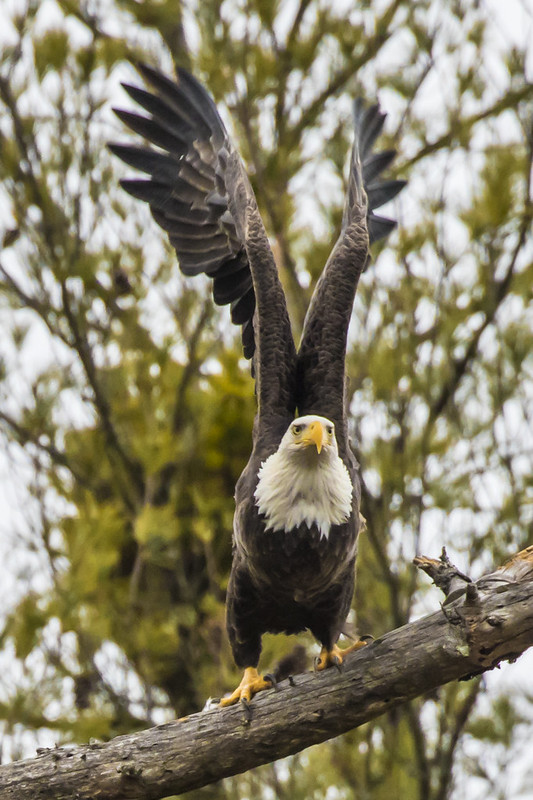Read Our Blogs
December Kayaking at Fairy Stone State Park
Shared by Glen Mitchell, as Guest Blogger.
My wife and I had a very busy year in 2019, and as a result we didn’t get to kayak nearly as much as we wanted to. On the last weekend before Christmas, we decided that we were way overdue to get some time on the water so we loaded the kayaks and headed to our favorite spot, Fairy Stone State Park. The temperature was 28 degrees according to the thermometer on the car’s dashboard. It was also cloudy, so it probably wouldn’t be warming up soon. I worried that we wouldn’t see any wildlife on such a glum day. I needn’t have worried.
We launched and went left, paddling near the shoreline. After just five minutes, I saw what I thought was a stump sticking out of the water near the shoreline. When I looked closer, I realized that it was an otter watching me.


It swam around, staying near the shore, clearly curious about us. It would swim, pull out on a log, then swim some more.


We didn’t want to bother the otter or disrupt its routine, so we moved on. Shortly after that, we got our second surprise of the day; in the trees above us we saw a bald eagle. We had seen plenty of ospreys at Fairy Stone but never eagles. It perched for a while then flew to another tree – and landed next to a second eagle! We were thrilled to see them and hoped that they were a nesting pair.



A little farther down we saw four more otters on a log against the bank. They were too far away to get a good photo, but I snapped one and tried to get closer. By the time I got nearer to them there were only two left on the log while the others were swimming around. They let me get some photos and watch them for a while. We decided to let them go about their business and left the cove.


We decided to head to the other shoreline to see what we could find there. As we crossed the lake, we spotted a merganser and a grebe swimming together. I hadn’t known that these two species would socialize, but there they were. They would swim together, separate for a few minutes, then come together again.

As we went down the opposite shore, my wife shouted at me to look up. I did, and on the tree not ten feet above my head was a pileated woodpecker. Pileateds are very recognizable due to the large size and the red crests on their heads. We see them almost every time we come to Fairy Stone but never this close, or for more than a few seconds. However, this one was apparently accustomed to humans and it seemed oblivious to our presence. It hammered at the bark, making several holes in its hunt for food. I took several photos and paddled off. Last we saw it, it was still pecking away.


We continued to the next cove, which is adjacent to the beach and the park’s boathouse.
Because of its shallow water and abundance of downed trees, it is a great spot to see wildlife. There, swimming with several mallard ducks, was a small female bufflehead. This was another species I hadn’t seen there before. They were swimming in the middle of the cove and seemed slightly startled so we didn’t get any closer and let them be.

We decided to call it a day and headed back to the boat ramp. What had seemed like an unpromising start had led to one of our best kayaking trips ever.
Thinking about kayaking this winter? Here are some tips to consider before heading out.
- Kayak rentals are not available at parks during the winter but you can bring your own.
- Be aware of the water temperature. The American Canoe Association’s standard for safe paddling is that the sum of the air temperature and water temperature be greater than 120. If the sum is below 120, protective clothing, like a dry suit, is recommended. Cold water shock from immersion can be deadly. This is a "do it at your own risk" activity.
- Always wear a life jacket.
- Always check the weather and tides before you paddle.
- Wear appropriate clothing including closed toe shoes.
- Don’t paddle under the influence.
- Always file a float plan.
- Know your paddling ability.
- Don’t stand up in swift moving water.
- Know and obey navigation rules.
- Avoid paddling in flood waters.
- Portage around low head dams
If you have read the article and have a question, please email nancy.heltman@dcr.virginia.gov.
Search for blogs
By Park
Categories
Cabins
Camping
Fishing
History and Culture
Other
Programs and Events
Trails
Volunteers
Water Fun
Archive
2025
2024
2023
2022
2021
2020
2019
2018
2017
2016
2015
2014
2012













